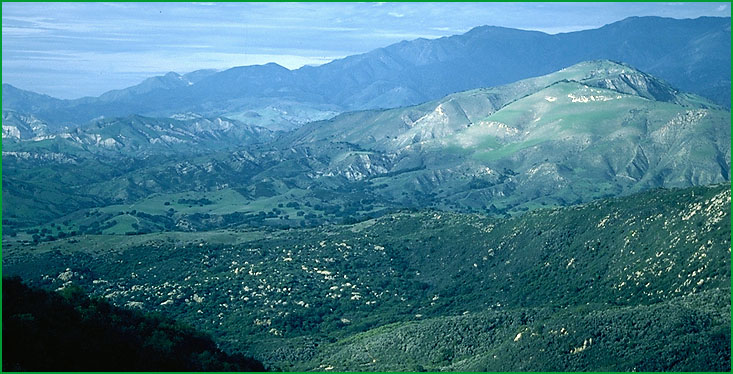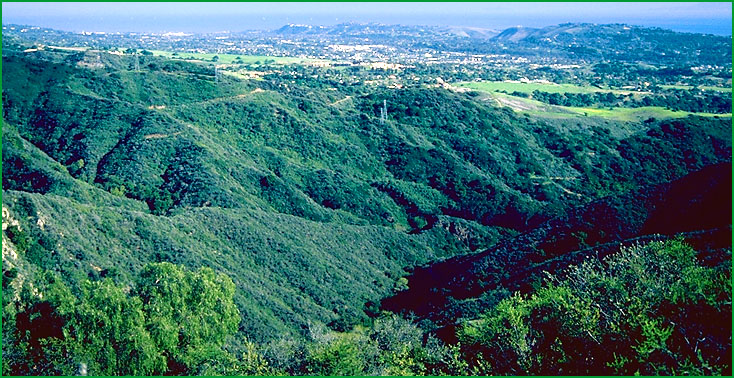 | Santa Ynez Hills and Valleys |
Lake Cachuma area from San Marcos Pass Ś Robert Ettner |
Santa Barbara area from San Marcos Pass Ś Robert Ettner |
http://www.fs.fed.us/r5/projects/ecoregions/261ba.htm
This subsection is in the northwestern part of the Transverse Ranges. It contains hills and dissected plains between Santa Ynez River and Santa Ynez fault on the south, the Santa Maria Valley on the north, and the San Rafael Mountains on the northeast. The climate is hot and subhumid and is modified greatly by marine influence. MLRAs 14d and 15d.
Lithology and Stratigraphy. This subsection contains predominantly Miocene and Pliocene marine and Plio-Pleistocene and Pleistocene nonmarine sedimentary rocks. Some rocks of the Franciscan Complex on the edge of the San Rafael Mountains are in this subsection. There is late Quaternary alluvium along the Santa Ynez River and San Antonio Creek and their tributaries. Dune sand is present along the coast.
Geomorphology. This subsection is on moderately steep to steep hills in Tertiary marine sediments and dissected plains on Pleistocene nonmarine sediments. Late Quaternary fluvial terraces and floodplains are extensive along the Santa Ynez River and are present, but not extensive, along San Antonio Creek and its tributaries. Sand dunes are present all along the coast, both adjacent to the beach and across the edges of plains that are near the coast. The subsection elevation range is from sea-level up to about 2000 feet, or less, in most of the subsection, but up to about 4000 feet on the edge of the San Rafael Mountain. Mass wasting and fluvial erosion are the main geomorphic processes. Fluvial deposition is an important process in the valleys. Wind is an important geomorphic agent along the coast.
Soils. The soils are mostly Typic and Lithic Xerorthents, Lithic and Pachic Ultic Haploxerolls, and Ultic Palexerolls on Tertiary marine and Plio-Pleistocene nonmarine sedimentary rocks. In Franciscan terrain they are mostly in Lithic subgroups of Xerochrepts, Haploxerolls, and Mollic Haploxeralfs. On Pleistocene nonmarine sediments, over which eolian sand has spread, they are Xeropsamments, Haplic Durixeralfs, and Typic Albaquults. On late Quaternary nonmarine terraces they are Haploxeralfs and Ultic Palexerolls and Palexeralfs. In sand dunes they are Typic and Alfic Xeropsamments and Entic Haploxerolls. Common soils on recent alluvium are Fluventic and Calcic Haploxerolls. The soils are well drained, except for poorly and somewhat poorly drained soils on nearly level Pleistocene nonmarine sediments. Most of them are leached free of carbonates. Soil temperature regimes are mostly thermic. Soil moisture regimes are mostly xeric, and some are aquic.
Vegetation. The predominant natural plant community is Coast live oak series. Blue oak series occurs on Plio-Pleistocene sediments at the east end of the subsection. Valley oak series is common on recent alluvial plains, and Fremont cottonwood series occurs along streams. Chamise series prevails on shallow soils in the eastern part of the subsection. The dunes support a succession of plant communities, from bare dune through herbaceous communities to Coyote brush series and California sagebrush series on stabilized dunes.
Characteristic series by lifeform include:
Dunelands: Sand-verbena - beach bursage series, Dune lupine - goldenbush series.
Grasslands: California annual grassland series.
Shrublands: Bigpod ceanothus series, Bigpod ceanothus - birchleaf mountain-mahogany series, Bigpod ceanothus - hollyleaf redberry series, Black sage series, California buckwheat series, California buckwheat - white sage series, California sagebrush series, California sagebrush - black sage series, California sagebrush series - California buckwheat series, Chamise series, Chamise - black sage series, Coyote brush series, Mixed sage series, Mixed scrub oak series, Purple sage series, Scrub oak series, Scrub oak - chamise series, White sage series, Woollyleaf manzanita series.
Forests and woodlands: Blue oak series, California bay series, Canyon live oak series, Coast live oak series, Valley oak series.
Climate. The mean annual precipitation is about 12 to 18 inches; it is practically all rain. Summer fog is common. Mean annual temperature is about 52░ to 60░ F. The mean freeze-free period is about 250 to 300 days.
Surface Water. Runoff is rapid and all but the larger streams are generally dry during the summer. There are no natural lakes, other than temporary ponding behind dunes.

